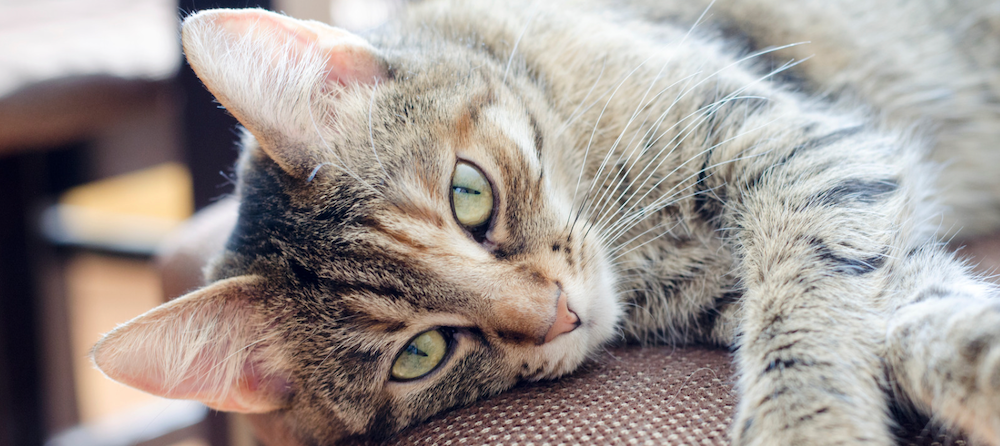If your cat was just diagnosed with asthma, read on! This is an all-too-common diagnosis that can be potentially life-threatening without treatment. Pet owners often fail to recognize cat asthma.
Most cat owners aren’t aware that cats can get asthma. And they often confuse the clinical signs of asthma with “coughing up a hairball.” The signs can be quite similar, and it’s important for you to be able to recognize what an asthmatic crisis looks like in a cat, as it can be fatal without rapid treatment.
What is cat asthma?
Asthma—which can be either acute or chronic—is inflammation of the lower airways that results in narrowing and increased “sensitivity” or responsiveness to stimuli (like dust, chemicals, aerosolized sprays, smoke, etc.). This inflammation of the lungs can result in chronic problems if untreated.
Breeds predisposed
Siamese cats are one of the most common breeds that get asthma, as it’s thought to be inherited in this breed. That said, any cat can develop asthma. Most cats show signs of asthma between 2-8 years of age.
Clinical signs
Signs of cat asthma include:
- “Hacking” or “coughing” up a hairball
- Increased respiratory rate (HINT: Count the number of breaths that your cat takes in 15 seconds and multiply by 4; if it’s greater than 50-60 breaths per minute, get to your veterinarian!)
- Open-mouth breathing
- Shortness of breath
- Using the abdominal muscles to try to breathe
- Wheezing sounds
- Lethargy
- Inappetence
- Difficulty breathing
- Blue or purple gums
- Acute death
You can see what the signs are here.
Diagnosis
The diagnosis of cat asthma can be tricky—often, it’s based on history, clinical signs, and x-rays (radiographs). However, I generally recommend doing a few other additional tests to confirm it, including:
- A complete blood count blood test
- A chemistry blood test
- A heartworm blood test
- A fecal sample (to check for the rare lungworm infection)
- A sedated lung wash (e.g., endotracheal lavage)
- Fluid analysis and culture of the endotracheal lavage fluid
- X-rays
- Possible echocardiogram or BNP blood test
With feline asthma, we often will see a certain type of white blood cells (e.g., eosinophils) that can be seen in both the blood work and the fluid wash from the lungs. Presence of eosinophils in cats typically is diagnostic for feline asthma. (However, other rule-outs include parasitic infections in the lungs, such as lungworm, heartworm, etc.) I’ll often culture the lung wash fluid to make sure a secondary bacterial infection (e.g., Mycoplasma) isn’t present. Lastly, radiographs are important, as they may show “bronchial” changes, consistent with feline asthma. Veterinarians often call these “donuts,” as they look like mini-white donuts on the x-ray. If your vet identifies these signs, your cat needs treatment for asthma.
If the initial tests don’t give a definitive answer, the next tests (which are more costly) may include doing an ultrasound of the heart (called an echocardiogram) or a blood test assessing heart function (e.g., BNP) to make sure the difficulty breathing isn’t from heart disease.
Treatment
So, how do we treat cat asthma? Well, it depends on how severe the asthmatic episode is.
If your cat is having a severe asthmatic attack, or difficulty breathing, please get to your veterinarian or an emergency veterinarian immediately, even if it’s in the middle of the night!
Treatment may include oxygen therapy, inhaled and intravenous medication, and supportive care until the crisis is over. Your cat will also be sent home on several medications to help with the treatment; this includes both oral and inhaled drugs for several days to weeks.
Typically, a course of prednisolone steroid therapy is needed. I usually start with 5mg every 12 hours orally and gradually taper this over a few days to weeks as clinical signs improve. If a bacterial infection is also present, the use of antibiotics may be necessary, but this should be based on culture results.
Once the initial acute inflammation is treated, chronic management can be done through inhaled drug therapy. My preferred way of treating cats chronically is with inhaled drug therapy as needed. Inhaled drugs include the use of albuterol and fluticasone (Flovent™). These are metered-dose human medications that are fit to a form-fitting facemask (Aerokat,™ Trudell Medical or Nebulair,™ DVM pharmaceuticals) designed for cats. When in doubt, discuss treatment options with your veterinarian, as there are several.
Prevention
Is there anything we can do to prevent a cat asthma attack? Yes! You can minimize any triggers or risk factors such as:
- Smoking in the house
- Chemicals
- Dusty kitty litter (I recommend using a brand like GreatLitter®, which is low-dust!)
- Hair sprays
- Air fresheners
- “Spring cleaning” with the cat around
I also recommend purchasing a High Efficiency Particulate Air (HEPA) filter for the room that your cat spends the most time in. I have one running for 10 hours on an automatic timer in the room where my Litter-Robot is. And while I use Litterbox.com litter, I still want to minimize any risk to my cat!
Prognosis
The prognosis is fair to good with cat asthma—it is totally treatable, but you have to be able to recognize the signs, make sure it’s diagnosed accurately and correctly, and treat it appropriately.
Help keep your cat healthy, happy, and breathing well, and know that asthma is treatable! It just requires careful vigilance and care. For more helpful information, visit Fritz the Brave.
References
- Miller CJ. Asthma, Bronchitis – Cats. In Blackwell’s Five-Minute Veterinary Consult: Canine & Feline. Eds. Tilley LP, Smith FWK. 2007, 4th ed. Blackwell Publishing, Ames, Iowa. pp. 114-117.









